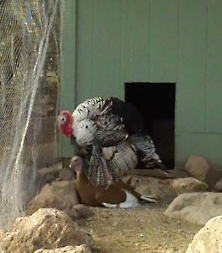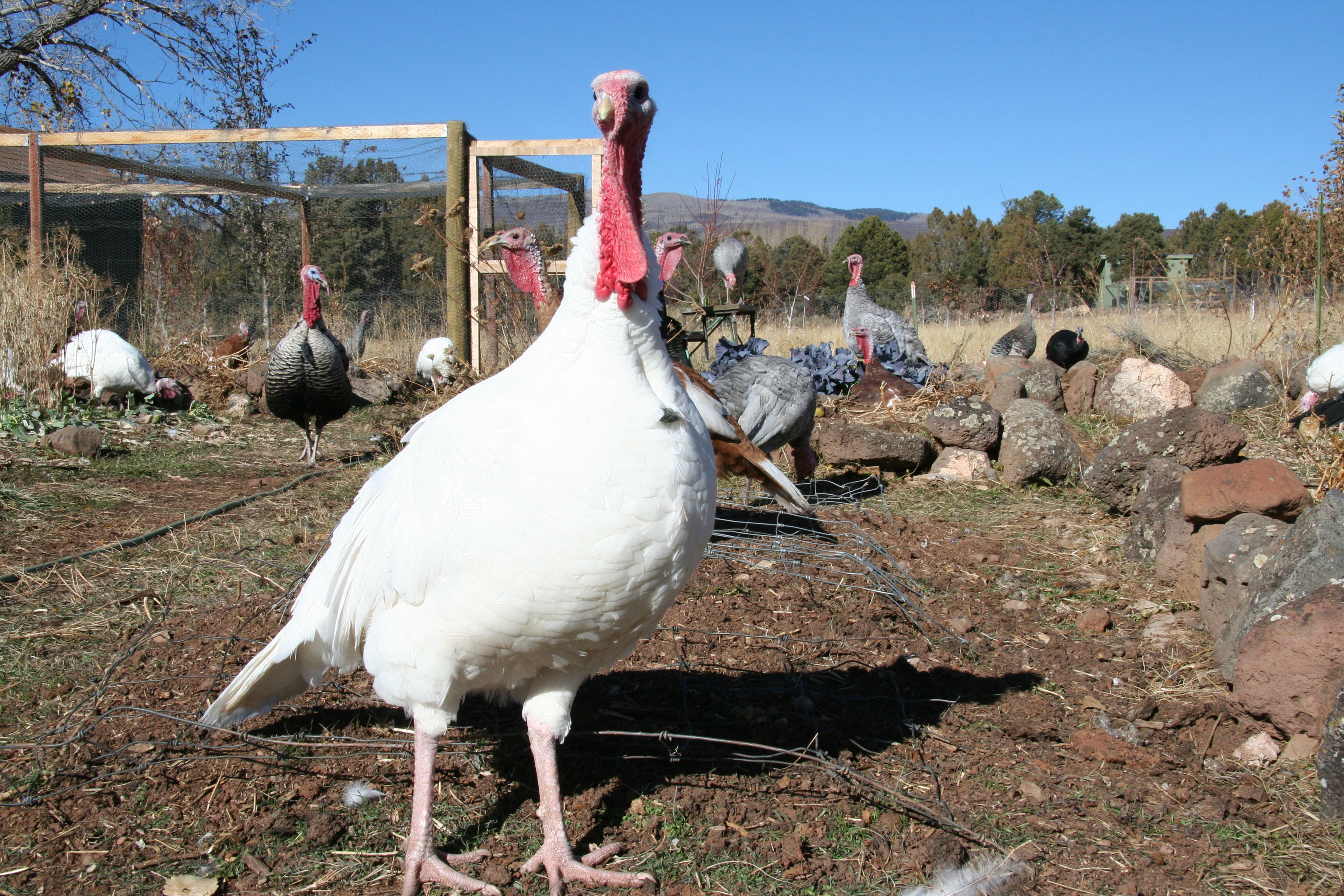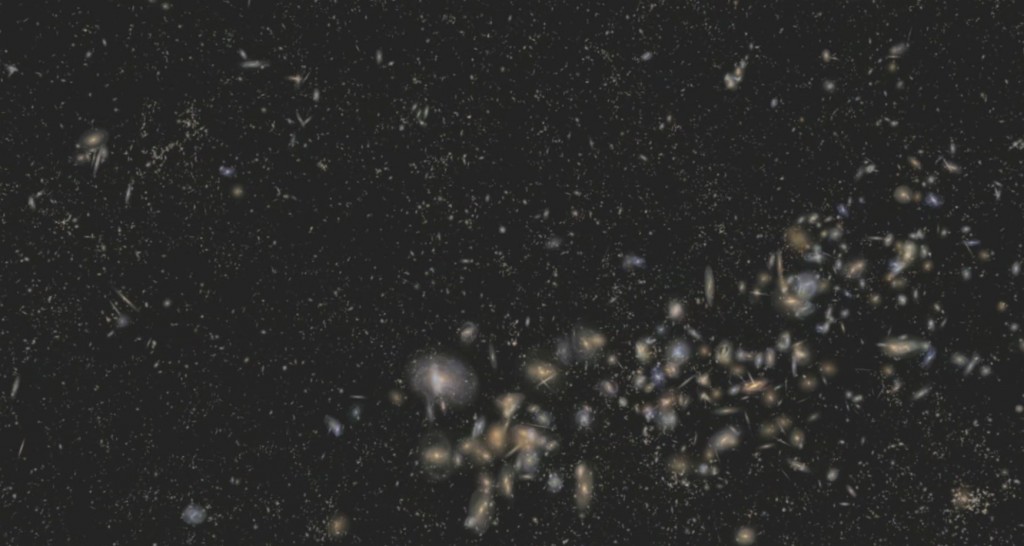 This picture is a still shot from a movie, and the little parade of galaxies marching diagonally across it is a section of one filament in a vast network of galaxies. Before I get to the point, let us pause a moment and reflect: these are fucking galaxies. They’re all Milky Ways of 10 billion solar systems each, maybe more. And they’re real, this is real data. I breathe deeply and move on. I wanted you to see this still picture before you see the movie. Continue reading
This picture is a still shot from a movie, and the little parade of galaxies marching diagonally across it is a section of one filament in a vast network of galaxies. Before I get to the point, let us pause a moment and reflect: these are fucking galaxies. They’re all Milky Ways of 10 billion solar systems each, maybe more. And they’re real, this is real data. I breathe deeply and move on. I wanted you to see this still picture before you see the movie. Continue reading
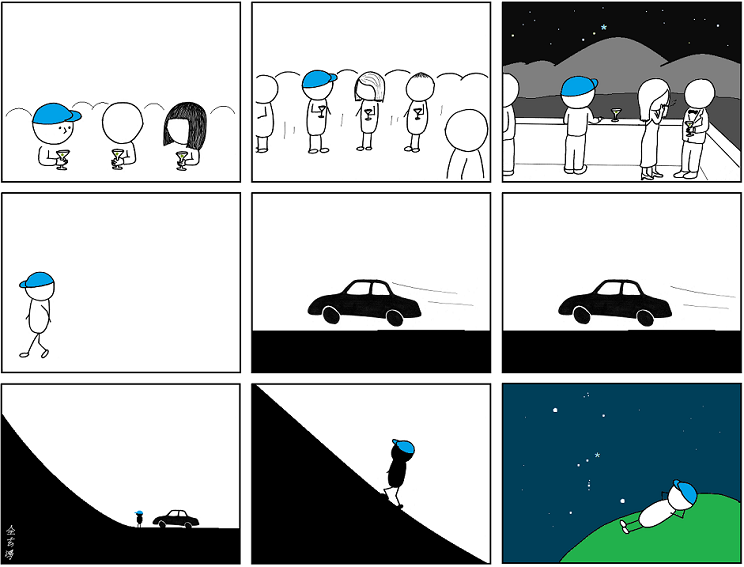 AG’s hypermeta mouseover thing says something about being in company but forever alone, and really, no disrespect to anyone having this feeling because it’s surely occasionally universal, but it’s also self-pitying nonsense and just not the case. Think about it for a minute: let’s say AG got tired of party chitchat and happened to notice Orion rising over the mountains, so he left and drove to where he could get a better view. The little star hanging off Orion’s belt is the Orion nebula in which, inside astronomically huge cold clouds, stars are lighting up, blowing their way out of the clouds in a blaze of ultraviolet glory. The four stars at Orion’s shoulders and legs are Rigel, Betelgeuse, Bellatrix and Saiph, all of which are blue-hot and probably young and noisy except Betelgeuse, which is a red supergiant getting ready to die by blowing itself to smithereens. No way is AG alone out there: Orion is major partytime.
AG’s hypermeta mouseover thing says something about being in company but forever alone, and really, no disrespect to anyone having this feeling because it’s surely occasionally universal, but it’s also self-pitying nonsense and just not the case. Think about it for a minute: let’s say AG got tired of party chitchat and happened to notice Orion rising over the mountains, so he left and drove to where he could get a better view. The little star hanging off Orion’s belt is the Orion nebula in which, inside astronomically huge cold clouds, stars are lighting up, blowing their way out of the clouds in a blaze of ultraviolet glory. The four stars at Orion’s shoulders and legs are Rigel, Betelgeuse, Bellatrix and Saiph, all of which are blue-hot and probably young and noisy except Betelgeuse, which is a red supergiant getting ready to die by blowing itself to smithereens. No way is AG alone out there: Orion is major partytime.
Not to mention that all AG has to do is look up and what he sees is infinity. Infinity, free gratis and for nothing, just by looking up. Alone schmalone.
__________
 For your Sunday-reading pleasure, a few stories that the people of LWON loved this week. In no particular order:
For your Sunday-reading pleasure, a few stories that the people of LWON loved this week. In no particular order:
Cameron and Christie:
“Over the Wall,” by Roger Angell, The New Yorker
Cameron says: It’s mainly about his wife, who died recently, and it ends up being very clever and hopeful, too. Also, I hope I can write like that when I’m 92. Or really, ever.
Ann:
“The Stars Are Beginning To Go Out…,” by Caleb A. Scharf, Scientific American Blogs
A nice clear post about the universe forming new stars more and more rarely, the fireworks slowing, the life force slacking off. Years ago, I covered a conference at which the news was the same, but then the star formation rate was an averaged estimate; this time, they’re looking at evidence for new stars in thousands of galaxies, over cosmic time. Sad, sad.
Christie:
“Attack of the Mutant Pupfish,” by Hillary Rosner, Wired
Spins a fascinating speciation story (bonus: the pizzly bear!)
“On Being Not Dead,” by Bill Hayes, New York Times
Oh my god, I love this essay. It captures the human experience in that magical way that an essay can make you feel less alone.
***
Open door image from Shutterstock.
I hope you nice people in the States had a lovely Thanksgiving.
This week, Ginny introduced us to the sleep molecule.
Jessa explained the 21st century superbear. It’s a hybrid between a polar bear and a grizzly, and it’s straight out of the anthropocene.
Christie considered a status symbol shared by male turkeys and female fashion victims.
Tom interviewed Matter’s head honcho Jim Giles, about his brand-new science magazine, and asked him about that freaky inaugural story.
And Cameron gave thanks to science, scientists, science writers, the world, and our readers in what should surely become an LWON tradition from here on out.
See you Monday! Good luck with the turkey hangover.
 One of my favorite newspaper columnists has a Thanksgiving column that has been reprinted more or less year after year for nearly two decades (or at least, that’s as far as the Chronicle’s online archives reveal). Along with talking about why, in a sea of holidays, Thanksgiving is the one that gets his wholehearted support, he pays tribute to an annually changing list of people who’ve been an essential part of his world that year.
One of my favorite newspaper columnists has a Thanksgiving column that has been reprinted more or less year after year for nearly two decades (or at least, that’s as far as the Chronicle’s online archives reveal). Along with talking about why, in a sea of holidays, Thanksgiving is the one that gets his wholehearted support, he pays tribute to an annually changing list of people who’ve been an essential part of his world that year.
I thought I’d start a similar, LWON-inspired list here, covering the people who I’ve come to realize have shaped my world in the last year or so. Please contest my choices and/or add your own below. Continue reading

Anna Sumner’s craving for sleep began when she was an 18-year-old high school senior. She thought nothing of it.
When it followed her to college, she blamed it on stress. She was working so hard, she told herself, her body just needed the extra rest. But it was more than that. She would choose naps over eating lunch, working out, or being with friends. Every night after dinner, she came back to her dorm room to sleep. If her parents called on those evenings, her roommate would cover for her, telling them she had gone to the library.
After graduation, Sumner moved to Bangkok to teach English. Her sleeping continued, and so did her rationalizations. It was OK that she was napping between every class because she was adjusting to a warm climate. Then she spent a winter working in London. There, her excuse was the dark and dreary sky.
Her parents started worrying after she moved back to the U.S. for law school. The summer after her first year, she lived at their house in Mississippi while working for a law firm. “Every day I’d go to work, come home, say ‘Hi Mom and Dad’, and go to bed,” she recalls. “That was the entire summer.”
Sumner needed sleep like an addict needs a fix. “It was this overpowering desire in me, a physical urge,” she says. “And there was always the hope that, maybe this time, I would wake up feeling better.”
Continue reading
Today, I give thanks for the snood. My amusement begins with the word itself, which rhymes with rude. Try enunciating it several times in a row, slowly, and you’ll see what I mean.
But the snood is more than just a delightful word and common crossword puzzle answer. It’s also a comedic example of sexual selection and the silliness of haute fashion. Continue reading
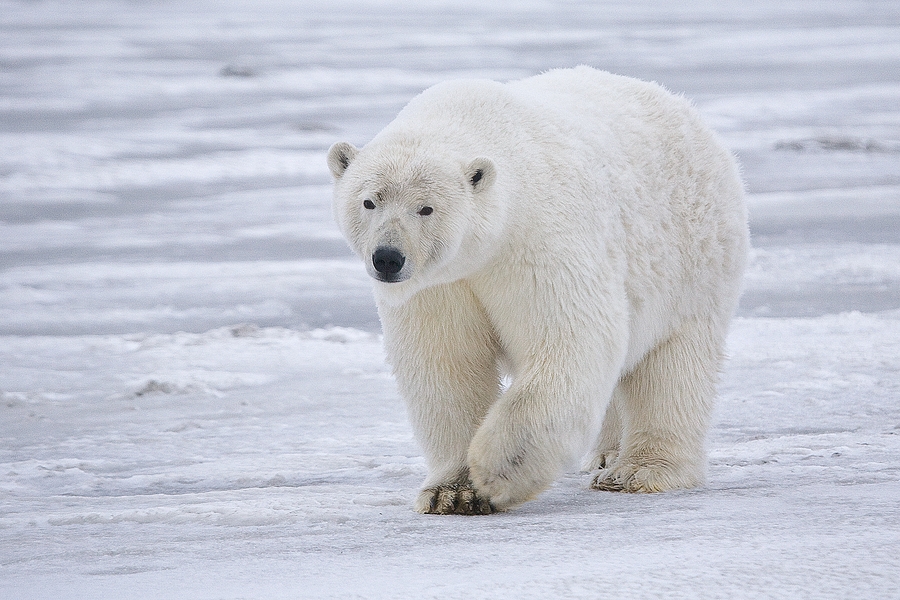 It’s amazing what scientists can do nowadays. They can get right down into the center of an atom. They can tell us in detail about rocks on other planets. So it’s no wonder when they report there are a certain number of very large animals in an area – and they only have to count up to a thousand or two – we tend to believe the number is pretty close. Population surveys for polar bears, for example, sound a bit like taking the census, only the bears don’t have phones.
It’s amazing what scientists can do nowadays. They can get right down into the center of an atom. They can tell us in detail about rocks on other planets. So it’s no wonder when they report there are a certain number of very large animals in an area – and they only have to count up to a thousand or two – we tend to believe the number is pretty close. Population surveys for polar bears, for example, sound a bit like taking the census, only the bears don’t have phones.
In reality, counting white animals against a white backdrop from a helicopter, over hundreds of thousands of square kilometers, is actually pretty tricky. Ditto caribou against the tundra. It’s also really expensive, so when a survey is done, those numbers have to be used for a decade or two, in combination with other measures, to estimate the health of a population.
When an August 2011 survey of Hudson Bay’s 8000km western coastline found 1,013 bears – 66% higher than the extrapolated estimates that had led to endangered status and trade moratoria on bear parts in the EU and US –the results were met with incredulity. The numbers confirmed reports from the Hunter and Trapper Associations in the area who have consistently seen more bears, but have been discredited by their immediate financial interest in raised hunting quotas.
Every year, about 450 foreign hunters each pay around $50,000 for a tag to shoot a polar bear, accompanied by an Inuit guide. For the North American Super Slam, and other large animal lists that prescribe the hunter’s complete trophy room, a dead polar bear is de rigeur. In China and Russia, a polar bear pelt can fetch $15,000. (You may be thinking laws against this would be wise regardless of bear population numbers, and you would not be alone.) Continue reading
